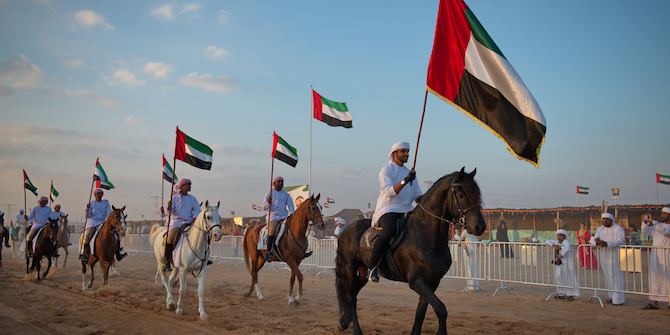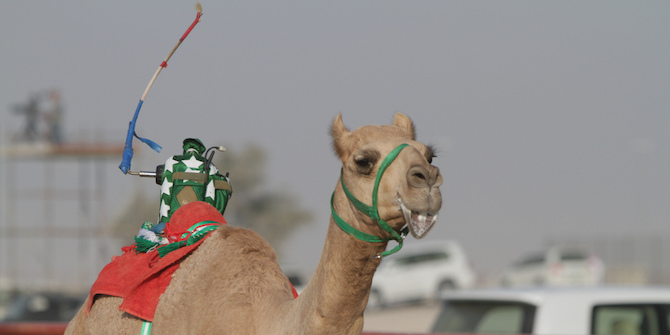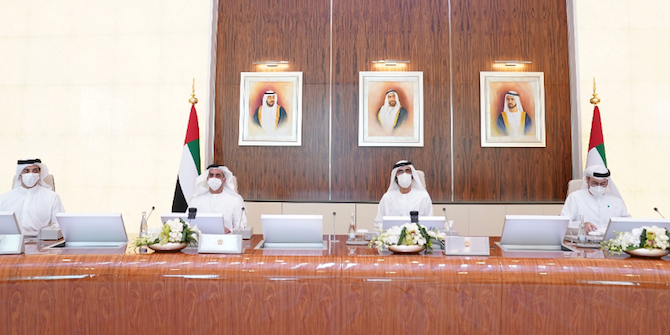by Karen Exell
This is part of a series of memos presented as part of a workshop organised by the LSE Middle East Centre on 5 October 2018, looking at national identity and the Emirati state.

Any discussion of national identity in the Arabian Peninsula in 2018 arguably must reference the Gulf crisis which began on 5 June 2017 when Saudi Arabia, the UAE and Bahrain, together with Egypt, broke diplomatic ties with Qatar and closed their borders. In Qatar, this event resulted in an unprecedented expression of loyalty for the Emir Sheikh Tamim from across the diverse population, only around 12% of whom are Qatari nationals, the remaining 88% comprising foreign residents from around 100 countries, and a reconfiguring of what it means to belong to the Qatari nation on the eve of the opening of the new National Museum of Qatar. In the UAE, the planning of the Zayed National Museum in Abu Dhabi has recently come back on track after a hiatus which saw the opening of the adjacent Louvre Abu Dhabi to global acclaim and the dramatic re-alignment of regional alliances. The Gulf crisis and the resulting reconfiguration of Gulf state relationships has created a condition of robust definition of national identity against close neighbours despite a long shared regional cultural history and the distribution of families and tribes across national borders. Of note is the ongoing court case in the International Court of Justice focusing on the UAE’s alleged discrimination against Qatari nationals on the basis of national origin, foregrounding the political need to define and defend discrete national identities which, prior to the hostilities, were worn lightly by Gulf citizens.
A New Politics of National Identity
The first wave of national museums opened in the Arabian Peninsula in the late 1960s and 1970s. These museums were intended to legitimise the rulers of the newly independent Gulf states and to cohere a new form of identity – the national – drawing on shared traditions and activities. National museums in development today are opening in a context that makes defining the nation and national identity more challenging.
One strategy is to use an architecture of spectacle that transcends internal and regional socio-historical complexities, as well as communicating national brands to the world, and furnishing new icons for contemporary nations. The design by Foster+Partners for the Zayed National Museum is inspired by the falcon hunting tradition, a sport popular across the Arabian Gulf and long-championed by the UAE as central to its national identity, architecturally referenced through a series of five spectacular curved towers representing falcon feathers, sitting on a plinth shaped as an abstraction of the topography of the Emirates. In Qatar, Jean Nouvel’s national museum design is inspired by the desert rose, a crystalline desert formation. While falconry is integral to the UAE’s national identity, its architectural abstraction takes it to a new symbolic level; in Qatar, the desert rose had no national associations prior to Nouvel’s design, but today features in nation branding imagery rolled out across Qatar Airways and other national brands.
Meanwhile, in Qatar, state actors have deliberately associated the new National Museum with a shift in the country’s socio-cultural agenda towards a new definition of the national and the local that revolves around diversity and inclusivity, utilising the museum as a tool to position Qatar on the moral high ground in response to the crisis. For example, on the 2 November 2017, Sheikha Al Mayassa, Chairperson of Qatar Museums and sister of the Qatari Emir, gave the keynote address to the Seventh Hamad bin Khalifa Symposium on Islamic Art at Virginia Commonwealth University in Richmond, Virginia, where she said, ‘Ours is a country made-up of diverse populations, over one hundred different nationalities live in Qatar. In such a place where many cultures intersect and people cohabit peacefully and in harmony, the value of cultivating an open mind is paramount.’ In addition, Sheikh Tamim’s first public appearance in Qatar after the start of the crisis took place on the 20 June 2017 at the National Museum. The visit to the Museum was accompanied by a press release that quotes Sheikha Al Mayassa as saying:
Today marks a proud moment for Qatar as we announce the official opening date for our iconic National Museum. The museum is the physical manifestation of Qatar’s proud identity, connecting the country’s history with its diverse and cosmopolitan present. It will reflect a part of every Qatari’s life, representing our roots and identity.
This positive referencing of diversity in connection with Qatar’s National Museum implies that this museum may establish a precedent in how the nation is represented in museums regionally. This is a noticeable break with the way national museums across the region presented an exclusive nationals-only identity during the early phase of regional independence and nation-building in the late 1960s and 1970s, and can be interpreted as an agile response to the current geo-political climate. How robustly this agenda will be played out in the museum when open, and to what level accepted by the Qatari national population remains to be seen. It also remains to be seen what kind of nation the Zayed National Museum will construct and represent, and in what regional climate this museum will open.
This blog post is partially extracted from the following forthcoming book chapter:
Exell, K. 2018 (in press). ‘Adapting Ambitions at the Time of Crisis: Qatar’s Evolving International Cultural Strategies’, in The Qatar Crisis 2017: The View from Within, edited by Rory Miller. Doha: HBKU.
Karen Exell is Honorary Senior Research Associate at UCL Qatar, and a consultant at Qatar Museums. Recent publications include Modernity and the Museum in the Arabian Peninsula and The Global Spectacular: New Museum Architecture in China and the Arabian Peninsula, and the co-edited volumes, Cultural Heritage in the Arabian Peninsula: Debates, Discourses and Practices and Museums in Arabia: Transnational Practices and Regional Processes.
is Honorary Senior Research Associate at UCL Qatar, and a consultant at Qatar Museums. Recent publications include Modernity and the Museum in the Arabian Peninsula and The Global Spectacular: New Museum Architecture in China and the Arabian Peninsula, and the co-edited volumes, Cultural Heritage in the Arabian Peninsula: Debates, Discourses and Practices and Museums in Arabia: Transnational Practices and Regional Processes.
In this series:
- National Identity and the Emirati State by Courtney Freer
- Assessing Historical Narratives of the UAE by Victoria Hightower
- When Art and Heritage Collide: Artistic Responses to National Narratives in the UAE by Melanie Janet Sindelar
- Sports and Heritage in the UAE by Natalie Koch
- Why More Research on the Bottom-Up Constructions of National Identity in the Gulf States is Needed by Idil Akinci
- State Building, State Branding and Heritage in the UAE by Rima Sabban
- Monolithic Representations of ‘Arab-ness’: From the Arab Nationalists to the Arab Gulf by Rana AlMutawa






